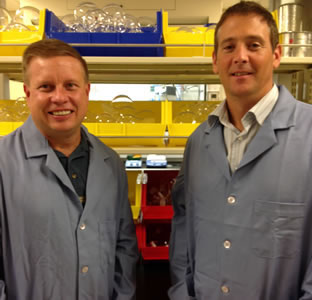UTSA, UT Health Science Center announce Center for Innovation in Drug Discovery

UTSA representatives in the partnership are Doug Frantz, CIDD co-director and Stanton McHardy, CIDD medicinal chemistry core director

UTSA representatives in the partnership are Doug Frantz, CIDD co-director and Stanton McHardy, CIDD medicinal chemistry core director
(Sept. 11, 2012) -- Taking homegrown discoveries -- research findings observed in laboratories in San Antonio -- and turning them into drugs to treat disease is the focus of the Center for Innovation in Drug Discovery (CIDD) being built at both The University of Texas at San Antonio (UTSA) and the UT Health Science Center San Antonio.
Doug E. Frantz and Stanton McHardy in the UTSA Department of Chemistry are building a medicinal chemistry core facility in labs on the UTSA Main Campus. Frantz, the CIDD co-director, and McHardy, the CIDD medicinal chemistry core director, have nearly 20 years of experience between them with Merck and Pfizer.
"Several top-tier universities have established centers dedicated to the discovery and development of new drugs that will treat devastating human diseases," said Frantz, whose vision was a driving force in the center's formation. "The most successful of these enterprises have included faculty and research staff who bring pharmaceutical industry experience to the table. Both Dr. McHardy and I have worked on U.S. Food and Drug Administration-approved drugs during our professional careers, and we believe these experiences will greatly benefit the CIDD here in San Antonio."
CIDD Co-Director Bruce Nicholson, professor and chair of biochemistry in the School of Medicine at the UT Health Science Center, and Matthew Hart, the CIDD high-throughput screening director, are developing a high-content/high-throughput screening core facility that will enable researchers to rapidly sift through thousands of potentially therapeutic compounds. This will be housed at the Joe R. and Teresa Lozano Long Campus of the Health Science Center starting in November, but the high-content imaging screens are already operational in temporary laboratories at the Texas Research Park.
"In order to identify small molecules or peptides that can bind to a protein or impact a cellular process that could represent a good target for disease therapy, you need the capacity to test and compare thousands of compounds to see which one works the best," said Nicholson. "The high-throughput and high-content screening facility will bring this capability to the San Antonio research community. We will offer not only biochemical screens to test how well potential drugs bind their targets, but we will also provide screens of live cells to assess compound effects on cell behavior."
The CIDD is designed to help develop drugs out of original discoveries made at the Health Science Center and UTSA to treat all forms of disease and infection. "San Antonio has always been among the top Phase I centers in the country," said Nicholson. "But, what we've not done very much is take homegrown discoveries and turn them into the next-generation drugs. This center is designed to facilitate that."
This is particularly true in the case of cancer research, where for many years most of the new drugs tested at the Cancer Therapy and Research Center did not originate from the Health Science Center.
Phase I cancer studies are conducted to demonstrate a novel agent's safety in patients whose tumors are not responding to existing therapies. Phase II and further studies define optimum use of the medications.
The earliest phases of pre-clinical drug discovery can take many forms. Structural biology studies at the Health Science Center have identified many protein targets for therapy in Alzheimer's disease, Parkinson's disease, diabetes, cancer and other disorders, and teams are in the process of obtaining high-resolution structures of these targets. This can be very effective in guiding the design of new drugs.
In other cases, scientists in many departments at the Health Science Center and UTSA have identified specific cellular processes central to the development of a disease that present ideal targets for therapy and in some cases have identified compounds or novel plant extracts that can affect them.
"The pre-clinical advancement of new small molecule drug-like candidates requires a multi-disciplinary approach and a diverse platform of research support," said McHardy. "The overall strategy for the CIDD at UTSA and the Health Science Center is to pull the successful strategies used in the pharmaceutical and biotechnology sectors and provide them to researchers to help advance small-molecule therapeutics for truly novel pharmacological targets and the treatment of numerous diseases."
Education is another key component of the center. Currently, UTSA undergraduate and graduate students in Frantz's laboratory are conducting research on breast cancer, prostate cancer and regenerative medicine involving stem cell differentiation, and addressing diabetes and neurodegenerative diseases such as Alzheimer's and Parkinson's diseases. Additionally, many graduate students at the Health Science Center are involved in designing therapeutic strategies to combat these same diseases. New courses in the emerging area of academic biomedical research are being developed and could lay the groundwork for a future graduate training program between these institutions.
The new center is expected to help with recruitment of outstanding faculty and graduate students to San Antonio in the field of medicinal chemistry and drug discovery. "Fruitful interactions are also anticipated between the CIDD and the UT Health Science Center's Institute for Integration of Medicine and Science (IIMS)," said IIMS Director Robert Clark, M.D. "Accelerating the pathway of drug discovery and development from the laboratory bench to initial testing in patients is one of our key objectives, and we are very enthusiastic about the impact that the CIDD will have in this area."
"Texas is seeing burgeoning development in biotech and drug discovery, and this new initiative will allow our students to have research opportunities that could eventually have global impacts on therapeutic treatments for patients," Frantz said. "I think this center will be a huge attraction and recruiting tool for us to show outstanding chemists why UTSA, working alongside the UT Health Science Center, is on a phenomenal trajectory to reach Tier One status."
State and private funding of $3.5 million is launching the CIDD. Support from the Texas Legislature is enabling renovation of existing research space, and the Legislature also provided funds through the San Antonio Life Sciences Institute. A generous private gift will be announced soon by UTSA.
------------------------------
The University of Texas at San Antonio is one of the largest of nine academic universities and six health institutions in the UT System. As a multicultural institution, UTSA aims to be a national research university providing access to educational excellence and preparing citizen leaders for the global environment. UTSA serves nearly 31,000 students in 135 degree programs in the colleges of architecture, business, education and human development, engineering, honors, liberal and fine arts, public policy, sciences and the Graduate School. Founded in 1969, UTSA is an intellectual and creative resource center and a socioeconomic development catalyst for Texas and beyond.
The University of Texas Health Science Center at San Antonio, one of the country's leading health sciences universities, ranks in the top 3 percent of all institutions worldwide receiving federal funding. Research and other sponsored program activity totaled $231 million in fiscal year 2011. The university's schools of medicine, nursing, dentistry, health professions and graduate biomedical sciences have produced approximately 28,000 graduates. The $736 million operating budget supports eight campuses in San Antonio, Laredo, Harlingen and Edinburg.
Events
This event will acknowledge graduating seniors from the McNair Scholars program at UTSA before inducting the new cohort of scholars into the program.
North Paseo Building (NPB 5.140), Main CampusAt this memorable celebration, UTSA graduates will be introduced one-by-one to cross the stage and accept their doctoral degrees.
Arts Building Recital Hall, Main CampusRoadrunner Walk is an event for graduating students to have a memorable walk on campus to celebrate an important milestone and their achievements. Graduates will walk along the Paseo while being celebrated by the UTSA community, friends, and family members.
Student Union Paseo, Main CampusCelebrate the accomplishments of College of Education and Human Development, College for Health, Community and Policy, College of Sciences and University College.
Alamodome, 100 Montana St.Celebrate the accomplishments of Alvarez College of Business, College of Liberal and Fine Arts and Klesse College of Engineering and Integrated Design.
Alamodome, 100 Montana St.

